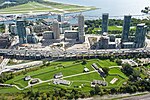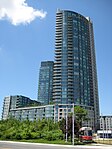Garrison Crossing
Bridges in TorontoCyclist bridges in CanadaPedestrian bridges in CanadaTied arch bridges in Canada

The Garrison Crossing (formerly named Fort York Pedestrian and Cycle Bridge), located in downtown Toronto, provides a link between Stanley Park in the north and the Garrison Common of the Fort York grounds in the south. The crossing includes two stainless steel bridges over rail corridors. The bridges form an important pedestrian and cyclist link to the Waterfront that also connects three parks - Ordnance Park, South Stanley Park with the Fort York neighbourhood.
Excerpt from the Wikipedia article Garrison Crossing (License: CC BY-SA 3.0, Authors, Images).Garrison Crossing
Garrison Crossing, Toronto
Geographical coordinates (GPS) Address Nearby Places Show on map
Geographical coordinates (GPS)
| Latitude | Longitude |
|---|---|
| N 43.638928 ° | E -79.407793 ° |
Address
Garrison Crossing
Garrison Crossing
M5V 1A9 Toronto
Ontario, Canada
Open on Google Maps








